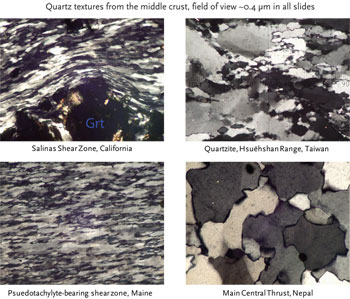Deciphering the Stress History of Middle Crustal Rocks
By:
Steven Kidder
Caltech
| When: | Friday, October 8, 2010, 10:30 a.m. to 11:30 a.m. Join us for coffee beginning at 10:00 a.m. |
| Where: | Seminar Conference Room, 10100 Burnet Road, Bldg 196-ROC, Austin, Texas 78758 |
| Host: | Harm Van Avendonk, UTIG |

Abstract
Current understanding of crustal rheology relies heavily on laboratory experiments carried out on quartzite at strain rates roughly a billion times faster than occur naturally. While there is sound theoretical basis for "trading temperature and time" in the extrapolation of flow laws from experimental to geologic conditions, there remains a great need for independent estimates on crustal strength. I provide new field- and laboratory-based constraints on this problem. I first test stress-grain size relationships in middle crustal rocks brought to the surface by the active Taiwanese orogenic wedge. These rocks have a well understood five-million year deformation history allowing the construction of a rheologic dataset independent of laboratory-based flow laws. These data are consistent with recent, widely used flow laws for quartz, but raise questions regarding the uncertainty of stress estimates and their extrapolation to cool and often non-steady-state geologic conditions. A new series of experiments motivated by observations in Taiwan establishes the kinetics of recrystallized grain size evolution in quartzite and provides evidence that, as predicted by Austin and Evans (2007), recrystallized grain size is a function of temperature and strain rate in addition to stress. The relationship derived by Austin and Evans (2007), when combined with field-based rheological studies in active, well-constrained natural laboratories, will provide an important new rheologic dataset that both complements and tests the current predominantly laboratory-, geophysical- and geodynamics-based understanding of lithospheric rheology.




